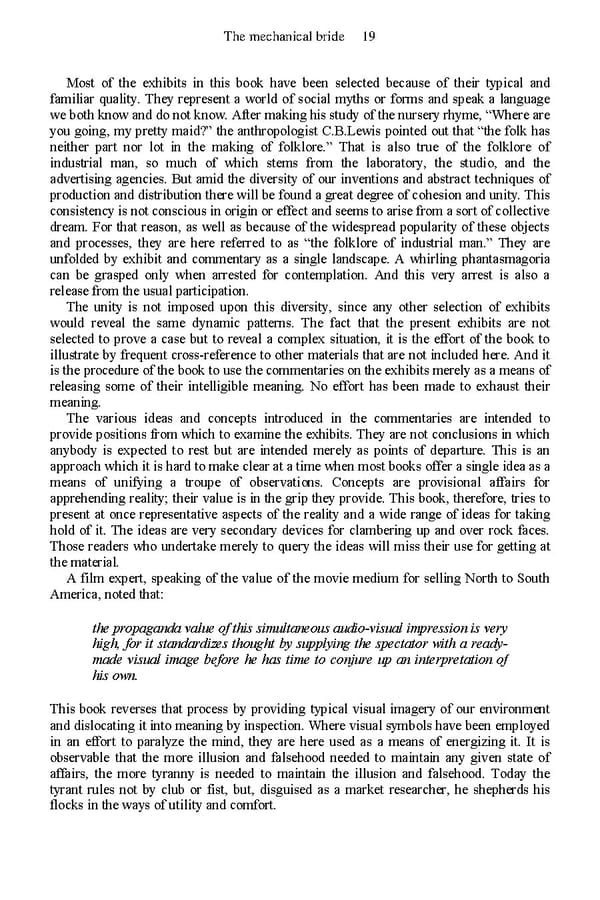The mechanical bride 19 Most of the exhibits in this book have been selected because of their typical and familiar quality. They represent a world of social myths or forms and speak a language we both know and do not know. After making his study of the nursery rhyme, “Where are you going, my pretty maid?” the anthropologist C.B.Lewis pointed out that “the folk has neither part nor lot in the making of folklore.” That is also true of the folklore of industrial man, so much of which stems from the laboratory, the studio, and the advertising agencies. But amid the diversity of our inventions and abstract techniques of production and distribution there will be found a great degree of cohesion and unity. This consistency is not conscious in origin or effect and seems to arise from a sort of collective dream. For that reason, as well as because of the widespread popularity of these objects and processes, they are here referred to as “the folklore of industrial man.” They are unfolded by exhibit and commentary as a single landscape. A whirling phantasmagoria can be grasped only when arrested for contemplation. And this very arrest is also a release from the usual participation. The unity is not imposed upon this diversity, since any other selection of exhibits would reveal the same dynamic patterns. The fact that the present exhibits are not selected to prove a case but to reveal a complex situation, it is the effort of the book to illustrate by frequent cross-reference to other materials that are not included here. And it is the procedure of the book to use the commentaries on the exhibits merely as a means of releasing some of their intelligible meaning. No effort has been made to exhaust their meaning. The various ideas and concepts introduced in the commentaries are intended to provide positions from which to examine the exhibits. They are not conclusions in which anybody is expected to rest but are intended merely as points of departure. This is an approach which it is hard to make clear at a time when most books offer a single idea as a means of unifying a troupe of observations. Concepts are provisional affairs for apprehending reality; their value is in the grip they provide. This book, therefore, tries to present at once representative aspects of the reality and a wide range of ideas for taking hold of it. The ideas are very secondary devices for clambering up and over rock faces. Those readers who undertake merely to query the ideas will miss their use for getting at the material. A film expert, speaking of the value of the movie medium for selling North to South America, noted that: the propaganda value of this simultaneous audio-visual impression is very high, for it standardizes thought by supplying the spectator with a ready- made visual image before he has time to conjure up an interpretation of his own. This book reverses that process by providing typical visual imagery of our environment and dislocating it into meaning by inspection. Where visual symbols have been employed in an effort to paralyze the mind, they are here used as a means of energizing it. It is observable that the more illusion and falsehood needed to maintain any given state of affairs, the more tyranny is needed to maintain the illusion and falsehood. Today the tyrant rules not by club or fist, but, disguised as a market researcher, he shepherds his flocks in the ways of utility and comfort.
 Essential McLuhan Page 25 Page 27
Essential McLuhan Page 25 Page 27